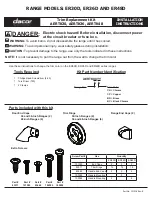
26
General cleaning
Before performing any
cleaning or maintenance,
unplug the cooker and close
the gas taps. The cleaning
should be done with the
cooker cold.
Do not use, under any circumstances, cleaning
agents such as chlorine, bleach, kerosene,
gasoline, solvents, removers, acids, vinegar,
juice lemon, chemicals or abrasives because
they can cause stains and accidents.
To clean the cooktop, remove the grids, burners
and knobs. Wash the cooktop and the other parts
individually, using a soft sponge, neutral detergent
and water.
Do not use in the cooktop the green
part sponges, abrasive powders and corrosive
substances that may scratch the part.
To
remove the toughest dirt from grids and burner
caps, use a dry steel wool sponge in the dry parts,
making circular movements.
Before putting them in their places, dry them well
and make sure they were all clean and dry. Make
sure they are properly seated.
Turn the burners
on and leave it lighted for about 1 minute to
ensure a complete drying.
There may be rust points on the bottom of the
burner cap, on the unpolished area. However,
oxidation of these points does not interfere with
the operation of the cooker.Do not use aluminum
foil to line the cooktop of the cooker because it
can cause stains on the cooktop and prejudice the
functioning of the spark plugs. Do not let acid or
alkaline substances, such as vinegar, coffee, milk,
salt water, juice tomato etc., remain for a long time
in contact with surfaces of the cooktop, burners
or enameled surfaces (burner caps, trivets, top
and bottom parts of the oven). In case of spills,
do cleaning immediately. In the cooktop grods is
normal to appear white or silver marks that seem
risks. These marks occur due to the metal residue
in pans bottom that is accumulated in the grids,
but they are easily removed using a steel dry
sponge.
The cleaning the burners, caps and spreaders
must be made periodically with warm water and
mild soap or neutral detergent for dishwasher.
Do not spill liquid or solid inside the burner to not
deragulate the flame or cause clogging. If this
happens, turn the burner off and wipe with a damp
cloth.
Be careful especially when the cooktop is with no
burners. Do not drop residues in the gas system,
as it can deregulate the flame or clog in the small
5. Cleaning and Maintenance
hole of the gas outlet.
If that happens, use a
specifi c needle for cleaning cookers.
Keep the
spark plugs clean and free of dirt burners crusts.
Burners cleaning
Avoid that food be spilled on the burners during
the cooking. If this occurs, clean them immediately
after use. Prolonged use of burners containing
food residues become cleaning very difficult.
Do not leave parts of the burner immersed in
detergent with water for more than 10 minutes.
Do not place the hot burners in cold water because
it can cause warping by thermal shock.
Important recommendations
For a lower consumption
of gas and better use, we
recommend using poans with
a diameter adapted to the
size of the burners (figs. 1
and 2), preventing the flame
burns in the vacuum (fig. 3).
It is recommended that
when the liquid starts to
boil, the flame is reduced
to a minimum possible,
maintaining the boil. Ensure
that there are air circulation
in the room where cooker is
installed. To facilitate ignition,
light the burner before placing
pan on the grid. Lower or turn
the flame off before removing
the pan.
During cooking, when using oils and other fats,
you must be aware because if they are spilled,
they can catch fire.
Only use pans with flat bottom that guarantee a
good stability on the grids.
6. Tips and Advices
TABLE OF MINIMUM AND MAXIMUM
DIAMETER OF PANS
Burner
Minimum
diameter
Maximum
diameter
Triple crown
24 cm
26 cm
Large
18 cm
26 cm
Medium
12 cm
22 cm
Prelimin
18-Jul-2







































